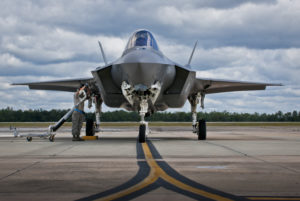The United States needs a new air-to-air missile that can keep up with the new active electronically scanned array (AESA) radars currently aboard the F-22 and F-35. The AMRAAM is a 1980’s era missile that “we’re close to maxing out”, Capt. Jim Stoneman, the Naval Air Systems Command program manager told the National Interest. The AESA radar can track targets well before the AMRAAM missile can engage them, and moreover, the U.S. is shockingly outranged by Chinese and Russian air-to-air weapons.
The Pentagon is doing some technology development work towards a new missile, but Stoneman acknowledged the AMRAAM is nearing the end of its development cycle. The weapon still uses the same missile body and rocket motor—and relies on a mechanically-scanned active radar seeker that operates in the X-band. “They’re always doing technology development,” Stoneman told The National Interest after his briefing. “We’ve probably close to maxing it out.”
Nonetheless, the AIM-120D is currently operational and is bringing “game-changing” capability to the fleet, Stoneman said. The missile offers greatly enhanced performance compared to older versions of the AMRAAM because of a new datalink and a new GPS system, which allows the weapon to follow a more precise path. The range advantage—despite the lack of new missile body or rocket motor—is enormous.
The Navy is currently working on software upgrades to enhance the missile’s resistance to enemy jamming, Stoneman said. The service has also added a home-on-jam capability to help deal with some of the advance jamming capability that is being fielded by potential adversaries, Stoneman said.
Those potential foes include Russia and China, whose jammers pose a huge challenge for the AMRAAM. Stoneman said it would take more than one missile to counter the new Russian and Chinese jammers—instead it would take a system-of-systems approach.
Meanwhile, an industry source told me that the United States needs a new air-to-air missile to take full advantage of the range of the new Active Electronically Scanned Array radars found onboard aircraft like F-22, F-35 and F/A-18E/F Super Hornet. The radars can track targets far before they are in missile range—and moreover—American missiles are grossly outraged by new Chinese weapons like the PL-15. Even some of the newest U.S. industry developments don’t match the estimated range of the Chinese weapon. However, the source did note that American estimates of the last alleged Chinese super weapons, the PL-12, were grossly overblown.
There’s news emerging from a U.S. Budget document that a new long-range weapon (LREW) is in the works that could target enemy aircraft beyond visual range. The LREW is currently classified, so there are very few details available. Some of the new features may include a ramjet engine and an AESA seeker, both of which our adversaries are already working on. Here Steven Trimble of Flight Global discusses the new LREW in detail:
Though funded for more than two years, the LREW project had escaped notice in an obscure budget line item for an OSD account named “emerging capabilities technology development”, which is mostly reserved for small electronic warfare projects.
But the programme offers the first indication that the US military is interested in a new missile to replace or surpass the capabilities of the Raytheon AIM-120D AMRAAM.
An unclassified concept image of the LREW was published last April in a presentation by Chuck Perkins, the principal deputy to the assistant secretary of defense for research and engineering.
The image in Perkins’ presentation may not reflect the classified version of the LREW concept, but depicts a large, two-stage missile launched from an internal weapons bay of a Lockheed Martin F-22.
The LREW also emerges as Chinese and Russian militaries reportedly are pursuing new air intercept missiles with ranges significantly longer than the AIM-120D. The range of the AIM-120D is classified, but is thought to extend to about 100mi (160km).






